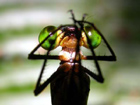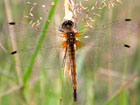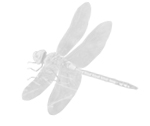|
|
|
|
Home | Trip Reports | Recent Sightings | Blog | Photographs | Phonescoping | Sonograms | Sketches | Patches | Butterflies & Dragonflies |
|
|
| The Dragonflies of Ayrshire | Ayrshire (vice-county 75), in south west Scotland, has 11 resident species. Due to its geographical location in Europe, Ayrshire is rather poor in terms of species diversity and none of the northern specialities such as the Emeralds (Somatochlora and Cordulia species) and the White-faced Darter (Leucorrhinia dubia) are known to occur.
Ayrshire is largely dominated by forested and grazed uplands (to 782 m) in the north, east and south, and pastoral and mixed farmland in central areas. Smaller tracts of bog, peat moss, and various wetlands harbour the most valuable sites in the county.
Migrant Hawker (Aeshna mixta) is a recent colonist, following the first records in 2004 and 2008, and is further evidence of the northward range expansion of this species in the British Isles. It would certainly be worthwhile searching for an additional six species which may occur: Emperor Dragonfly (Anax imperator) and Southern Hawker (Aeshna cyanea), Azure Hawker (Aeshna caerula), Variable Damselfly (Coenagrion pulchellum), Irish Damselfly (Coenagrion lunulatum) and Keeled Skimmer (Orthetrum coerulescens).
Emerald Damselfly Lestes sponsa Status: Locally common. Habitat & Distribution: Within Ayrshire this species is best looked for resting on vegetation surrounding bog pools in the uplands. Also known from lushly-vegetated lowland pools. Flight Period: Early July to late September.
Large Red Damselfly Pyrrhosoma nymphula Status: Common. Habitat & Distribution: Widespread throughout from acidic wetlands in the uplands to eutrophic ponds and burns in the lowlands. Flight Period: Late May to late July.
Azure Damselfly Coenagrion puella Status: Locally common. Habitat & Distribution: Known mainly from lowland areas where it occurs at well-vegetated ponds and reservoir corners. Flight Period: Early June to mid August.
Common Blue Damselfly Enallagma cyathigerum Status: Common. Habitat & Distribution: Widespread in the county and may be encountered at most aquatic environments. Flight Period: Early June to late Augus
Blue-tailed Damselfly Ischnura elegans Status: Locally common. Habitat & Distribution: Widespread, occurring at many different water bodies from acidic lochs, garden ponds and brackish sites. Usually in small numbers. Flight Period: Early June to late August.
Common Hawker Aeshna juncea Status: Fairly common. Habitat & Distribution: In Ayrshire, mainly restricted to upland areas where it may be found breeding in bog pools and feeding along forestry rides. Occasionally encountered in lowland and urban areas. Flight Period: Early July to late September.
Migrant Hawker Aeshna mixta Status: Locally common. Habitat & Distribution: The first record from Barony Pit in 2004 (FSS). Currently undergoing a northward range expansion in the British Isle and a species to be on the look-out for. Now breeding in the Irvine-Kilwinning area. Flight Period: August to October.
Emperor Dragonfly Anax imperator Status: Rare. Colonising. Habitat & Distribution: First recorded in 2021 from an acid bog pool site in the Carrick Hills (MKS). Present again in 2022 (DE). Flight Period: July-September.
Golden-ringed Dragonfly Cordulegaster boltonii Status: Small numbers in suitable habitats. Habitat & Distribution: Widespread in uplands areas, particularly along fast flowing burns and forest tracks. Flight Period: late May to early September.
Four-spotted Chaser Libellula quadrimaculata Status: Small numbers locally. Habitat & Distribution: Widespread but local in a variety of habitats from boggy upland pools to flooded sand pit and estuarine habitats in central Ayrshire. Flight Period: Early May to late July.
Common Darter Sympetrum striolatum Status: Common, occasionally abundant. Habitat & Distribution: Widespread from the coast to the uplands in a variety of habitats. May be encountered well away from the emergence site. Large numbers in favourable years probably involve migrants from further south. Flight Period: Mid-July to mid-October.
Black Darter Sympetrum danae Status: Small numbers in favoured environments. Habitat & Distribution: An upland species occurring mainly around acidic bog pools. Infrequently found in the lowlands in early autumn as the adults undergo migratory movements. Flight Period: Mid-July to mid-October.
About | A-Z Index | Search this Website | Links | Ayrshire Bird Report | Ayrshire Bird Race | Scarlet Banded-Barbet | Blog Index |
|
|
© Fraser Simpson · www.fssbirding.org.uk |
|







